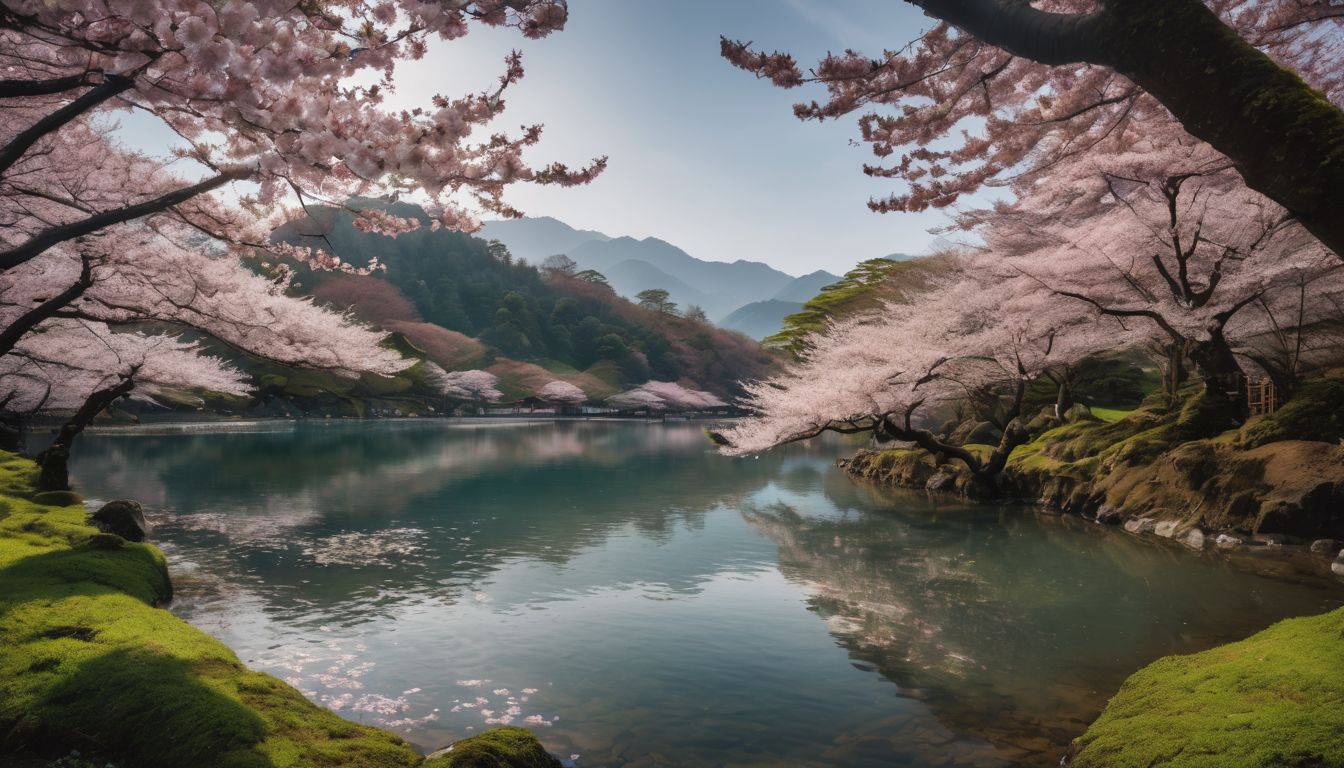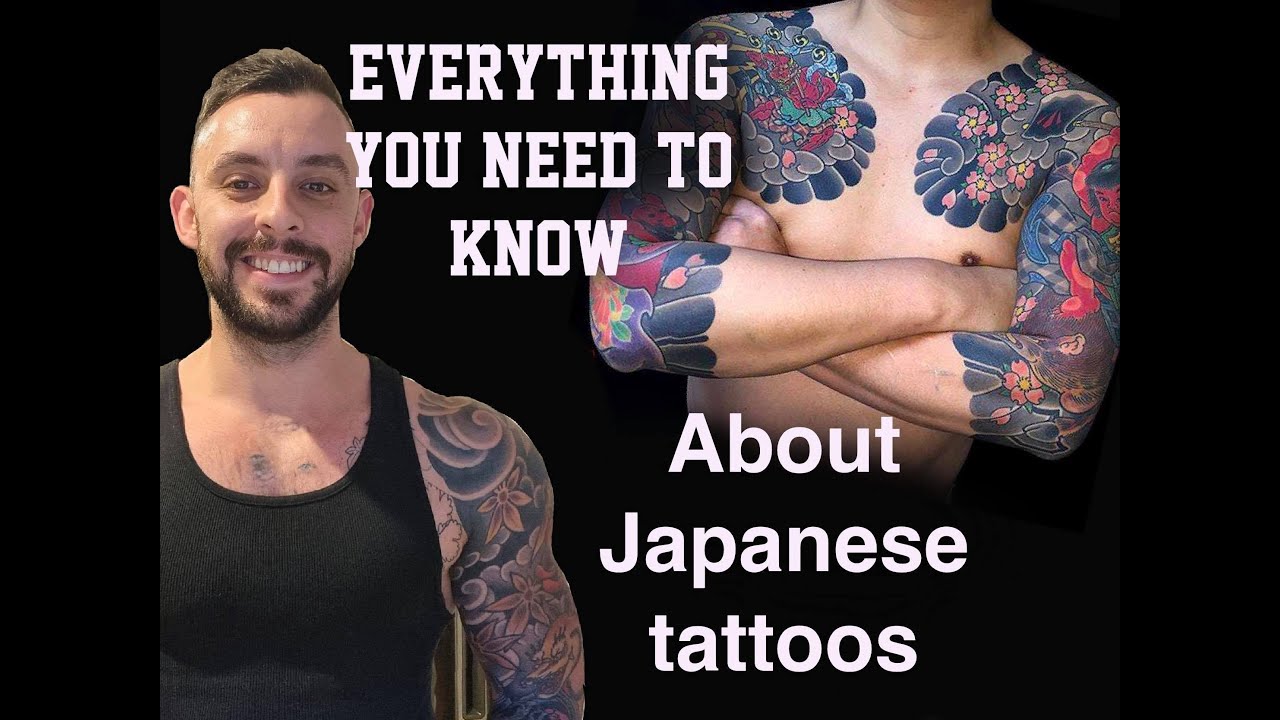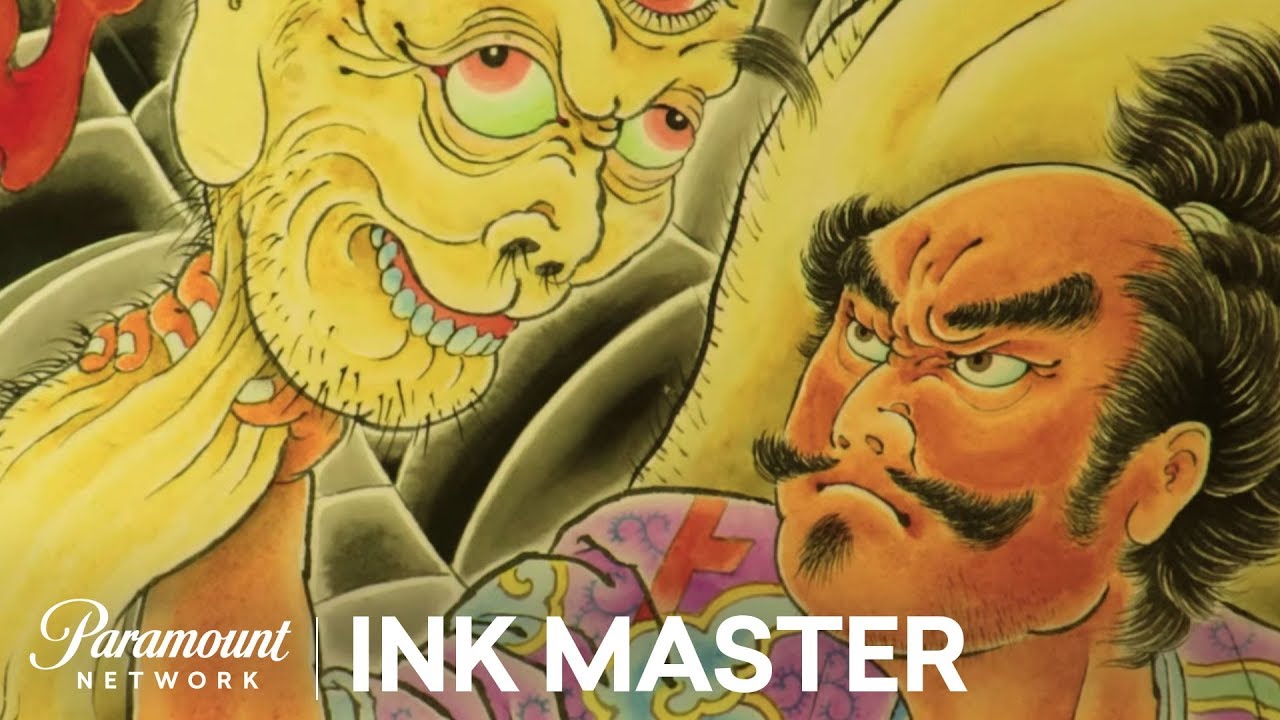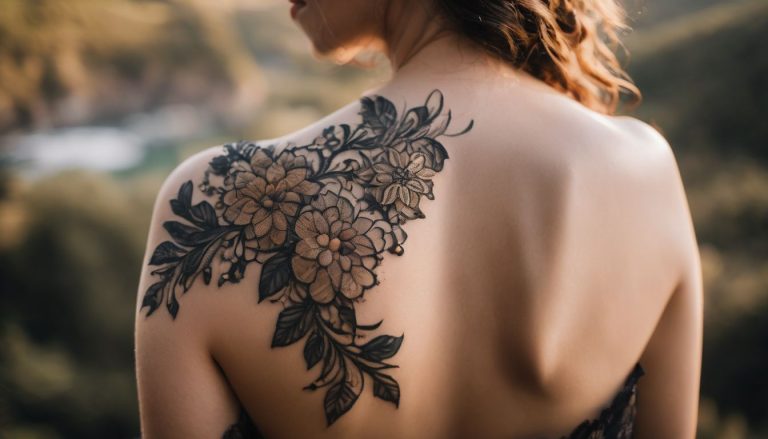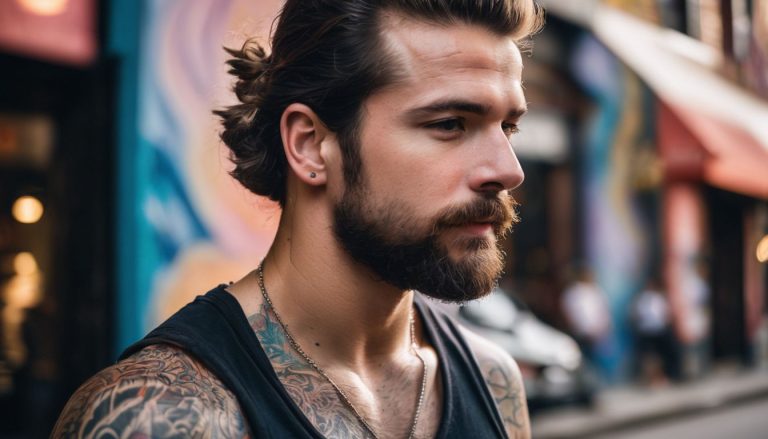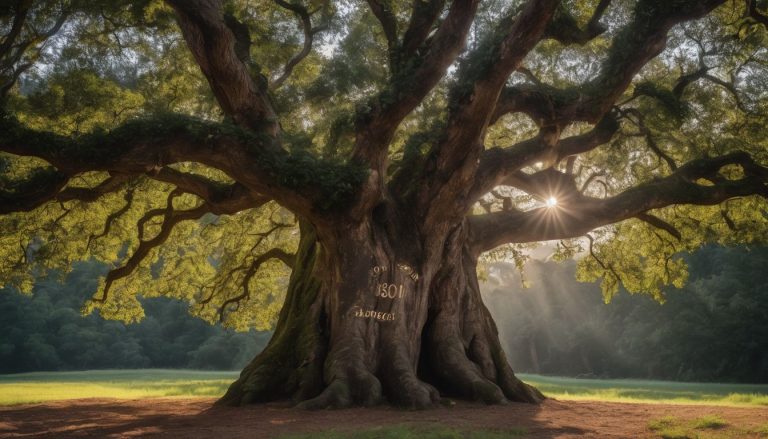Exploring the Meaning Behind Japanese Tattoo Designs
Create your own unique tattoos and art for your home
Deciding on a tattoo design can be tough, especially when you crave something rich in history and meaning. Japanese tattoos are a tapestry of art and storytelling, each symbol packed with cultural significance.
This blog will unveil the deep meanings behind popular Japanese tattoo designs, helping you choose one that resonates with your personal story. Discover the inked legacy that could become part of your own skin.
Key Takeaways
- Japanese tattoos, known as Irezumi, are rich in history and cultural meaning, often representing protection, courage, and other deep significances rooted in folklore.
- Popular designs like dragons symbolize strength and good fortune; samurais stand for honor and bravery; cranes represent longevity; geishas convey beauty and grace; tigers indicate protection; koi fish signify perseverance.
- Traditional placement of these tattoos often covers large areas with full body suits or is focused on the back and shoulders to tell a story or demonstrate social status.
- Tebori is the traditional hand – poked tattooing technique that offers a unique aesthetic quality but requires longer healing times than machine tattoos due to its meticulous process.
- Despite past associations with criminal activity, modern society sees Japanese tattoos as art forms worthy of appreciation for their beauty and storytelling.
The History of Japanese Tattoos
Traditional Japanese tattoos have a long history, often used as symbols of status and protection. The art of irezumi, or traditional Japanese tattooing, has evolved over centuries to become an integral part of Japanese culture with its own unique substyles and symbolism.
Traditional uses and meanings
In the past, Japanese tattoos served as symbols of status and spiritual protection. High-ranking samurais inked their bodies with family crests and symbols of power, while others used Irezumi to ward off evil or signify devotion to a patron deity.
Tattoos were not merely decorations but held deep significance within the fabric of society. They communicated a person’s history, beliefs, and even aspirations. Farmers might wear tattoos that prayed for good harvests; merchants sported designs promising wealth.
Spiritual protectors like dragons or phoenixes were popular choices for individuals seeking strength or rebirth. A snake tattoo suggested wisdom and protection; wearing one was believed to bring good fortune into one’s life.
The meaningful nature of these images meant every mark told a story—a practice deeply interwoven with Japanese folklore and tradition. As we delve deeper into Irezumi substyles in our next section, it becomes evident how this purposeful art form evolved over time.
Irezumi and other substyles
Irezumi is a traditional style of Japanese tattooing that has deep cultural and symbolic significance. Its intricate designs often feature various mythical beasts, such as dragons and phoenixes, which hold specific meanings like protection, wisdom, rebirth, and triumph.
Irezumi also encompasses other substyles like Tebori, characterized by the traditional hand-poke method using sharpened bamboo or steel needles. This unique technique gives tattoos a distinctive texture and depth while carrying on centuries-old traditions.
Another noteworthy substyle is Horimono – full-body suits with bold color palettes reflecting elements from Japanese folklore.
Connection to crime in Japan
Japanese tattoos have historically been associated with the underworld and criminal elements in Japan. In the Edo period, tattoos were used to mark criminals as a form of punishment and to identify them within society.
This association between Japanese tattoos and crime has persisted over time, contributing to negative stereotypes and discrimination against those with visible body art. Despite this historical stigma, modern perceptions of Japanese tattoos are evolving, reflecting a growing appreciation for the cultural significance and artistic value of these designs.
The relationship between Japanese tattoos and crime in Japan remains complex, rooted in centuries-old traditions that continue to influence contemporary attitudes towards body ink.
Evolution and current cultural significance
Japanese tattooing has evolved from being associated with criminal activity to becoming a celebrated form of art and cultural expression. Today, Japanese tattoos are recognized for their rich symbolism and intricate designs, carrying deep meanings that reflect the country’s folklore and tradition.
These tattoos have become more widely accepted in modern society, finding a place not only as beautiful body art but also as symbols of strength, resilience, and personal storytelling.
The current cultural significance of Japanese tattoos lies in their ability to bridge the gap between tradition and modernity. They serve as a visual representation of Japan’s ancient myths and legends while simultaneously adapting to contemporary styles and interpretations.
Common Japanese Tattoo Designs and Their Meanings
Japanese tattoos often feature traditional designs such as dragons, samurai, cranes, geishas, tigers, and koi fish, each with their own unique meanings and symbolism. To learn about the deeper significance behind these iconic tattoo motifs, keep reading.
Dragon
The dragon is a common motif in Japanese tattoo art, representing strength, wisdom, and good fortune. In Japanese folklore, the dragon is seen as a powerful guardian that brings protection and prosperity to those who are worthy.
The dragon’s presence in traditional Japanese tattoos signifies courage and resilience, making it a popular choice for individuals seeking to convey these qualities through their body art.
With its intricate scales and fierce appearance, the dragon serves as a symbol of might and determination in Japanese tattoo designs.
Samurai
The samurai, or warrior, is a popular motif in Japanese tattoos symbolizing honor, bravery, and loyalty. Often depicted in traditional armor with a sword at the ready, the samurai tattoo embodies discipline and strength.
These designs frequently incorporate cherry blossoms or other elements to represent the fleeting nature of life and remind individuals to live with courage and integrity. Samurai tattoos are impactful representations of ancient warrior values that continue to inspire respect and admiration.
Moving on from the significance of samurai tattoos, let’s explore another iconic Japanese design: Crane tattoos.
Crane
Having explored the significance of samurai tattoos, it’s fascinating to delve into the symbolism behind crane designs in Japanese tattooing. The crane holds deep meaning in Japanese culture and folklore, often symbolizing longevity, good fortune, and loyalty.
In Japanese mythology, cranes are believed to live for a thousand years and are revered as mystical creatures that bring happiness and eternal youth. As a result, crane tattoos are sought after for their representation of resilience, purity, and hope.
Cranes also hold important spiritual significance in Japan as messengers of the gods. Their elegant and graceful demeanor make them popular choices for tattoo designs among those seeking to embody strength and elegance simultaneously.
Geisha
Geisha tattoos are a popular choice, often symbolizing beauty, grace, and traditional Japanese culture. The geisha tattoo design may depict a geisha in vibrant attire, with intricate details showcasing elegance and poise.
Geishas hold deep significance in Japanese history and folklore, embodying femininity and artistry. These tattoos can also represent the virtues of patience, discipline, and dedication.
The geisha motif is frequently chosen for its association with performance arts such as dance, music, and tea ceremonies. Additionally, the geisha’s serene demeanor reflects harmony and balance in life—a fitting tribute to the timeless allure of Japanese culture.
Tiger
Japanese tattoos often incorporate the image of a tiger, representing strength, courage, and protection. In Japanese folklore, the tiger is considered a powerful and majestic creature that symbolizes fearlessness and guardianship.
The image of a tiger in Japanese tattoo designs often depicts the animal in an aggressive stance, showcasing its ferocity and dominance. This design reflects bravery and resilience against adversity.
Tiger tattoos also hold significance as a protective talisman against harm or evil spirits in traditional Japanese culture. They are believed to bring good fortune and ward off negative energy.
Koi
The koi fish holds significant meaning in Japanese tattoo designs. Symbolizing determination and perseverance, the koi represents overcoming obstacles and achieving success. With its vibrant colors and flowing movement, a koi design often embodies strength, resilience, and courage.
In Japanese folklore, the koi is associated with transformation and personal growth. These qualities make it a popular motif in traditional Japanese tattoos, reflecting the wearer’s journey towards triumph over adversity.
Koi fish tattoos are also linked to good fortune and prosperity in Japanese culture. The legend of the koi swimming upstream to transform into a dragon symbolizes ambition and aspiration for greater things in life.
Symbolism in Japanese Tattoo Designs
Japanese tattoo designs are steeped in symbolism, with each motif carrying its own unique meaning and significance. From protection and bravery to good luck, these tattoos hold a deep cultural and historical symbolism that goes beyond just aesthetics.
Protection
Japanese tattoo designs often incorporate symbols of protection, such as the snake and phoenix. The snake is revered for its association with wisdom, good fortune, and safeguarding against harm.
Additionally, the phoenix symbolizes renewal and resilience, serving as a protective emblem against adversity and misfortune. These powerful motifs reflect the deep-rooted belief in using tattoos to ward off illness, disaster, or bad luck in Japanese culture.
Tattoo enthusiasts are drawn to these protective symbols not only for their aesthetic appeal but also for their meaningful significance. The intricate portrayal of these protective emblems in Japanese tattoos showcases the rich storytelling tradition and symbolic depth that permeates through this unique art form.
Bravery
Japanese tattoo designs often incorporate symbols of bravery, such as the fierce samurai or the powerful dragon. These designs are not only visually striking but also carry deep cultural significance.
The samurai represents courage, honor, and loyalty, while the dragon is a symbol of strength and resilience. Both motifs reflect the enduring Japanese values of bravery in facing challenges and overcoming adversity.
In Japanese folklore, tattoos depicting mythical beasts like dragons were believed to bestow protection upon the wearer and inspire fearlessness in times of trouble. Similarly, samurai tattoos embody the spirit of bushido – the way of the warrior – emphasizing fearlessness and unwavering resolve in the face of danger or hardship.
Good luck
Symbolism in Japanese tattoo designs often revolves around the concept of good luck, reflecting the belief in positive energy and protection. Traditional Japanese tattoos feature motifs such as the koi fish, which symbolizes perseverance and good fortune.
The phoenix is also a popular choice, representing renewal and triumph over adversity. In addition, mythical beasts like dragons are often included to bring luck and strength to the bearer.
These symbolic Japanese tattoo designs not only serve as stunning body art but also convey powerful messages of hope and positivity.
Traditional Placement and Styles of Japanese Tattoos
Traditional Japanese tattoos are known for their full body suits, with designs covering the entire body. Smaller designs are also common, often placed on the back and shoulders to convey specific meanings and symbolism.
Full body suits and bodysuits
Japanese full body suits and bodysuits are elaborate and cover a large portion of the body, often from the neck to ankles and wrists. These intricate designs usually feature traditional Japanese motifs such as dragons, koi fish, samurai, and cherry blossoms.
Full-body tattoos have significant cultural significance in Japan and hold deep symbolism for those who wear them. The process of getting a full-body tattoo is lengthy, requiring multiple sessions with a skilled master artist.
The detailed nature of these tattoos reflects rich storytelling within the Japanese culture, conveying bravery, protection against evil forces, good luck, as well as honoring specific historical or mythological figures.
Smaller designs
Smaller Japanese tattoo designs hold significant meaning and symbolism. These intricate creations often feature elements such as cherry blossoms, lotus flowers, and small animals like koi fish or cranes.
The smaller size allows for detailed and delicate work, highlighting the rich cultural significance behind each design. From symbols representing good fortune to motifs symbolizing rebirth and resilience, these smaller Japanese tattoos are powerful expressions of art and meaning.
Tattoos with smaller designs are popular choices due to their versatility in placement. Often found on the arms, wrists, ankles, or necks, these tattoos can be easily incorporated into everyday life while still retaining their symbolic importance.
Placement on the back and shoulders
Japanese tattoos have traditional placement on the back and shoulders, showcasing designs such as dragons, samurai, and mythical beasts. These areas are chosen for their symbolic significance in Japanese culture, with the upper back representing protection and strength while the shoulders represent bravery and resilience.
The elaborate motifs inked onto these areas of the body often tell a story or convey deep personal meaning to the wearer.
The historical significance of placing tattoo designs on the back and shoulders dates back to ancient Japan when warriors adorned themselves with intricate artwork to display their status and courage.
Today, this placement continues to be popular among enthusiasts seeking to honor tradition or connect with Japanese folklore through their tattoo art.
Tebori: The Traditional Japanese Tattooing Technique
Tebori is a traditional Japanese tattooing technique with a rich history and cultural significance, involving hand-poking the design into the skin. To learn more about this unique and fascinating method of tattooing, continue reading our blog on Japanese tattoo designs!
Meaning and history of Tebori
Tebori, the traditional Japanese tattooing technique, has a deep historical significance and cultural importance. Dating back to centuries ago, Tebori is rooted in ancient Japanese traditions and mythology.
This form of tattoo art involves using hand-carving tools to create intricate designs directly on the skin. The word “tebori” itself translates to “hand-carved,” reflecting the artisanal nature of this practice.
Historically, Tebori was perceived as a sacred ritual and served as a rite of passage in Japanese society.
Pain and healing process
After undergoing the traditional Tebori tattooing technique, individuals can expect a longer healing process compared to modern machine-based tattoos. The hand-poked method causes more trauma to the skin, resulting in prolonged pain and increased time required for recovery.
During the healing period, it is essential to follow proper aftercare instructions, including keeping the tattooed area clean and dry, applying recommended ointments or moisturizers as per the artist’s guidance, and avoiding exposure to direct sunlight or soaking in water until fully healed.
Moreover, understanding that pain during the tattooing process is subjective helps individuals prepare mentally for their experience. It’s important to communicate openly with a skilled Tebori artist about any concerns regarding pain tolerance before starting the session.
Famous Tebori artists
Some famous Tebori artists, such as Horiyoshi III and Horikazu, have gained international recognition for their exceptional skill and dedication to preserving the traditional art of Japanese tattooing.
Horiyoshi III is renowned for his mastery in creating full-body Irezumi suits with intricate details that depict Japanese folklore and mythology. His work embodies the deep cultural significance of Tebori.
On the other hand, Horikazu specializes in Koi fish tattoos that symbolize perseverance and strength, showcasing the beauty of this ancient technique with a modern flair. These artists continue to honor the rich history of Japanese tattooing through their remarkable craftsmanship, perpetuating its legacy for future generations.
Female Tebori artists
Continuing the tradition of Tebori, female artists have made significant strides in the world of Japanese tattooing. Embracing this ancient art form, these skilled women bring their unique perspective and craftsmanship to the table.
Their dedication and mastery have contributed to the evolving landscape of traditional Japanese tattooing, bringing forth a new wave of creativity and innovation. Female Tebori artists add a fresh dimension to the intricate storytelling aspect of Japanese tattoos, infusing designs with their own interpretations while upholding centuries-old techniques passed down through generations.
Japanese culture values harmony and balance between elements, which is reflected in female Tebori artists‘ work as they continue to breathe new life into this time-honored craft. With a deep understanding of symbolism and cultural significance, they imbue each design with rich narratives that resonate with clients seeking not only beautiful body art but also meaningful expression.
Frequently Asked Questions about Japanese Tattoos
Discover the common themes and symbolism found in Japanese tattoos, learn about Irezumi symbology, find tips on choosing a design and artist, and get advice on taking care of a Japanese tattoo while understanding its cultural significance.
Common themes and symbolism
Japanese tattoo designs are rich in symbolism, with various motifs conveying significant meanings. Dragons symbolize strength, courage, and wisdom in Japanese culture. The samurai represents honor, discipline, and bravery.
Similarly, the crane embodies longevity, good fortune, and peace. Geishas symbolize beauty, elegance, and mystery while tigers represent power and protection. Koi fish are linked to perseverance and determination in the face of adversity.
Symbolism in Japanese tattoos is deeply rooted in folklore and tradition. The mythical creatures reflect various traits like protection against evil forces or representing rebirth and renewal.
Irezumi symbology
Moving from a discussion of common themes and symbolism in Japanese tattoos, we delve into the realm of Irezumi symbology. Traditional Japanese tattoo designs such as dragons, samurais, cranes, geishas, tigers, and koi are all deeply rooted in Japanese folklore and mythology.
These motifs hold rich symbolism representing protection, bravery, good luck and often serve as a visual narration of legendary tales. The mythical creatures found in these designs are not only visually stunning but also carry diverse meanings that have been passed down through generations.
From snakes symbolizing wisdom and good fortune to phoenixes embodying rebirth and renewal – each design is steeped in cultural significance.
Choosing a design and artist
When choosing a Japanese tattoo design and artist, it’s important to consider the cultural significance and symbolism behind the motifs. Look for an artist who specializes in traditional Japanese styles and has a deep understanding of the historical and mythological meanings embedded in the designs.
Consider your personal connection to specific symbols such as dragons, samurais, or koi fish, ensuring that they resonate with your own values and beliefs. Researching different artists’ portfolios will help you find someone whose artistic style aligns with your vision, while also considering their expertise in executing intricate details inherent in Japanese tattoos.
Consulting with experienced professionals can provide valuable insights into selecting a design that best reflects your individuality while staying true to the essence of Japanese tattoo symbolism.
Taking care of a Japanese tattoo
After choosing a design and artist, taking care of a Japanese tattoo is crucial for ensuring proper healing and longevity. It’s essential to follow the aftercare instructions provided by your tattoo artist as this will promote healing and reduce the risk of infection.
Keep your Japanese tattoo clean by gently washing it with mild soap and water, then patting it dry with a clean towel. Apply a thin layer of fragrance-free moisturizer to keep the skin hydrated but avoid using petroleum-based products as they can suffocate the skin.
During the healing process, avoid exposing your Japanese tattoo to direct sunlight, chlorine, or soaking in water for prolonged periods to prevent fading or damage. It’s important to resist picking at scabs or peeling skin as this can interfere with the healing process and affect the final appearance of your tattoo.
The cultural significance of Japanese tattoos.
The cultural significance of Japanese tattoos is deeply rooted in the country’s history and tradition. These tattoos were initially used to convey social status and serve as spiritual symbols, representing a connection to ancient mythology and folklore.
The rich symbolism, expressiveness, and bold features of Japanese tattoo designs continue to hold significant meaning for individuals who choose to adorn their bodies with these intricate artworks.
Throughout history, Japanese tattoos have been utilized as a means of self-expression and storytelling, allowing wearers to exhibit bravery, protection against illness or disaster, good luck, and various other personal beliefs.
Japanese tattoo motifs often reflect mythical beasts such as dragons and phoenixes that carry symbolic meanings of power, rebirth, triumph over adversity, wisdom, guidance, protection against evil forces or bad luck.
Conclusion
In conclusion, Japanese tattoos are steeped in rich symbolism and cultural significance. The designs serve as visual narratives, often conveying themes of protection, wisdom, and good fortune.
From dragons to samurais, each motif holds deep meaning tied to Japanese folklore and tradition. Exploring the world of Japanese tattoo designs offers a glimpse into an ancient art form that continues to captivate and inspire people worldwide.
FAQs
1. What do Japanese tattoo designs mean?
Japanese tattoo designs, known as Irezumi, often have deep meanings rooted in Japanese folklore and history, with each motif symbolizing different aspects of life or qualities like strength and wisdom.
2. Can you explain the symbolism in Irezumi tattoos?
Irezumi tattoos are full of symbolism drawn from myths and nature; for example, dragons represent power and protection while koi fish may symbolize perseverance due to their ability to swim upstream.
3. Where can I find inspiration for my own Japanese tattoo?
For inspiration on your Japanese tattoo design ideas, explore historical motifs or mythical beasts found in traditional Irezumi that tell stories through intricate artwork.
4. Are there any important traditions connected to Japanese tattoos?
Yes, there’s a rich tradition behind Japanese tattoos including their historical significance within the samurai culture and rules surrounding where and how they should be inked onto the body according to ancient practices.
5. How does understanding the meaning help when choosing a Japanese tattoo design?
Knowing the meanings behind various motifs helps you choose a design that resonates personally with you or conveys your intended message since each element used in a traditional Japanese tattoo has its unique interpretation based on centuries-old beliefs and stories.

